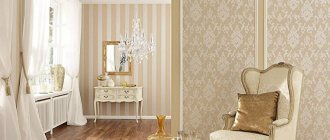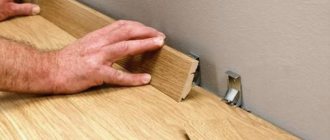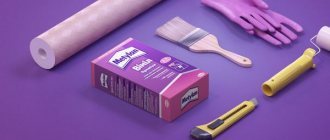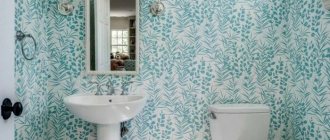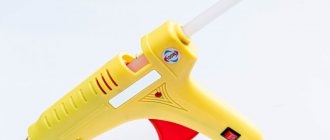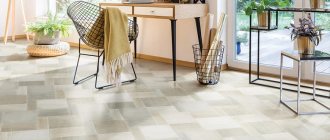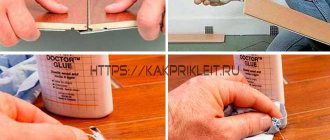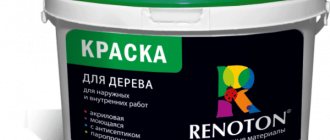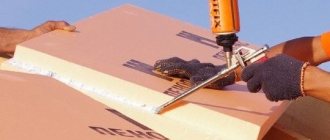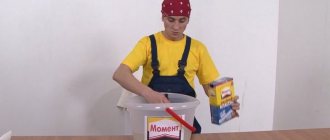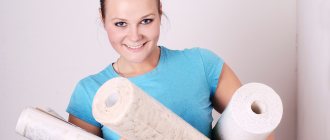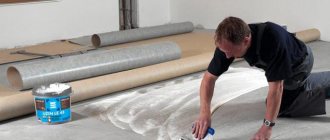If you have decided that you should have wallpaper on your walls, then at the same time you need to choose an adhesive for them. Each type of wallpaper presented in building and finishing materials stores has its own characteristics, so the choice of paste will depend on them.
To avoid guessing for a long time, take the most common glue for paper wallpaper and be sure that it will cope with its task. The only difficulty may be the variety of brands presented, as well as their price range - from the cheapest options to the most expensive.
Let's try to figure out together what the features of the most popular brands of wallpaper glue are.
Selection of glue for paper wallpaper
We will not dwell on the issue related to the calculation and selection of paper wallpaper. Let's go straight to the review of the glue that is best suited to paper wallpaper. In order for gluing to be quick and effective, wallpaper glue should only be used that is intended for wallpaper of this type. Wallpaper glue is a key link in a complex chain of finishing works; it must guarantee durable and high-quality adhesion to the wallpaper on the wall. If wallpaper adhesive is chosen correctly, you can use it to significantly simplify the process of gluing paper wallpaper to walls in a room or office space.
Glue "Quelyd"
The manufacturer offers a line of “Quelyd” wallpaper adhesive designed for different types of wallpaper, including vinyl and paper versions. If you prefer paper wallpaper, you will need "Quelyd", on the box, which says "for different types of paper wallpaper."
Price range
The cost of glue for paper wallpaper depends on several factors. The price depends on the manufacturer and the weight of the package. It is better to choose a manufacturer that is well-known in the construction industry, for example, choose Quelyd products from a variety of options.
Advice! Carefully study the entire range of adhesives intended for paper wallpaper. It is better to choose glue with an average cost.
Wallpaper adhesive rating
We offer a small overview of adhesives that are suitable for paper wallpaper. Inexpensive in price and of good quality, adhesives from the Quelyd brand are considered on the modern construction market. During its existence, customers have confirmed the excellent relationship between price and quality of this product; such glue can be purchased without worrying about its quality. In the middle price range are the products of the German company Ekon, which has found its fans not only in European countries, but also in Russia. As an alternative, you can consider glue from the Moment brand (domestic production), as well as products from the ProDecoro brand.
Attention! Adhesives of the Kleo and Metylan brands have a higher cost. They can hardly be called budget options.
Features of Quelyd
By choosing Quelyd glue for repairs, you become the owner of a ready-to-use, beautifully packaged mass. Currently, the Quelyd brand offers a huge range of products, so you need to carefully look at the manufacturer’s recommendations in order to choose the right wallpaper glue.
Attention! Don't try to save money by buying glue from questionable brands. It is better to immediately purchase products from those companies whose reputation has been proven over time.
For example, “kelid” is a high-quality French glue, which many wallpaper craftsmen speak positively about. If you decide to choose lightweight paper wallpaper for repairs, you can choose an adhesive that is created specifically for them. If you choose glue that is too cheap, you may be disappointed in its quality. Such a cheap substitute will wet the wallpaper, and you will not be able to get beautiful and even connections between the individual canvases. In addition, there is a high risk that after the wallpaper has completely dried, the seams between the individual canvases will separate, the design will be disrupted, and there will be no question of any aesthetics.
What is better – a ready-made solution or a dry mixture?
A ready-made mixture is the most convenient option when there is no time to dilute the mixture. The freed up time can be used to study the instructions and features of using glue. Sold in buckets, it costs more than dry glue.
Important! When purchasing a ready-made mixture, you need to make sure that the glue is aggregative. If the composition is too liquid, it may deteriorate in the near future, so you need to carefully monitor the expiration date. In a liquid state, the glue can remain for a relatively short time.
The finished composition has its advantages and disadvantages
Dry mixture. Diluting it with water is a fairly simple repair task. By following the instructions and adding a certain amount of water, mixing thoroughly and letting the composition “simmer” for some time, you can get a fairly tenacious thick glue. The main thing is to follow the instructions that are on each package. After cooking, you usually don’t have to wait long – from 3 to 20 minutes.
Preparing the adhesive mixture yourself also has its pros and cons.
For those new to construction and renovation, there are adhesive mixtures colored blue or pink . This is necessary in order to carefully monitor whether any “section” of the wallpaper was missed. The color disappears after drying - it becomes transparent, so this will not affect the quality of the gluing in any way. These adhesive models are more expensive than regular ones.
The buyer is also offered to purchase unusual wallpaper, on which a layer of glue has already been applied . To gain access to this glue, you need to remove the protective film. You won’t have to prepare the composition yourself, which further reduces the time but raises the price. True, such wallpaper is quite thin and brittle, so you need to work with it very carefully.
Wallpaper with previously applied glue is an ideal option for those who find it difficult to work with special compounds
Features of preparing glue for use
Standard adhesive for paper wallpaper is offered by the manufacturer in boxes and bags in powdered, dry form. This type helps to increase the shelf life of the composition and the use of glue. Thanks to this packaging option, you can transport the glue without any problems without using special sealed containers.
If desired, you can also purchase liquid glue, offered in tubes. Thanks to its special composition, liquid glue can be used to glue joints between sheets, glue corners, and treat hard-to-reach places.
Tips for using paper adhesive
All the main points regarding the use of glue are indicated by the manufacturer in the instructions provided on the back of the package. The packaging design is made in such a way that the number of rolls that can be glued using this mixture immediately catches the eye. In addition, the company that manufactured the glue always describes in detail the sequence of actions for preparing the mixture, the proportions used, the order and sequential actions performed. The algorithm for selecting and using glue can be seen in the video fragment
Attention! When calculating the consumption of wallpaper glue, which must be indicated on the packaging, the computer gluing method is used, which involves gluing the canvases to an ideal surface.
In reality, consumption can vary significantly, especially if the surface has a high degree of absorption. The proportions of water and glue that are indicated by the manufacturer on the packaging were obtained experimentally, so they must be observed when preparing a solution for gluing wallpaper. Otherwise, there is a high risk that the mixture will not provide high-quality adhesion between the canvas and the wall, and the service life will be significantly reduced. If you fully follow all the manufacturer's recommendations, you will be able to accurately determine the time frame for preparing the mixture for gluing. After the glue has completely thickened, it is suitable for use.
How to get rid of bubbles
Bubbles often occur during repairs. Even after rolling out the canvas well with a roller to knock out air from under the wallpaper, you may encounter the appearance of bubbles after the glue dries. Usually, when the glue dries, the fabrics tighten themselves and the bubbles go away, but sometimes they remain; this can be corrected by two methods.
Using a syringe into which the adhesive solution is injected, it is injected into the desired area. Next, use a spatula to squeeze out excess glue and wipe it with a rag. With a large bubble and thin wallpaper, it is permissible to create an incision with a sharp razor, then the glue is introduced under the wallpaper.
Cutting the razor may result from the appearance of cracks on the surface, so the test is carried out in an area where the experiment will not be visible.
You can remove bubbles using a syringe into which an adhesive solution is injected; it is injected into the desired area.
Features of application
Dilute the dry powder at room temperature. To work, you will need special tools and devices:
- basin or bucket;
- water;
- stick or mixer for mixing the composition.
Automatic kneading helps to obtain a composition that is uniform in consistency and will not leave marks on the paper webs. In addition, after complete drying, lumps of glue will disrupt the aesthetic appearance of the finished wall.
Advice! If you don't have an automatic mixer, you can use a regular stick instead. Pour glue into water, not the other way around!
First, water is poured into the basin at room temperature, the volume specified in the instructions, then wallpaper glue is poured in a thin stream. When adding it to water, it is important to constantly stir the mixture so that the adhesive component is evenly distributed throughout the entire volume of the liquid. In order for the composition to stand, you need to leave the finished mixture for 5-7 minutes. Then mix the prepared mixture again, checking that there are no lumps. If all the recommendations specified by the manufacturer are fully followed, you will receive a uniform, thick mass.
Criterias of choice
What criteria should be taken into account when choosing a suitable wallpaper adhesive:
- wall material;
- type of wallpaper;
- wallpaper weight;
- maximum room temperature;
- humidity.
When choosing glue, you need to find out how safe it is and whether it contains components that prevent the appearance of fungus and mold. Also, knowledge of the setting time of the glue cannot be neglected.
When choosing wallpaper glue, it is important to take into account many nuances - otherwise wallpapering may not go well.
Other important properties of the glue by which it is chosen are:
- density;
- moisture resistance;
- pH (it should be 6 or 7, otherwise stains may appear);
- life time;
- consumption;
- drying time of wallpaper;
- price per package.
It is worth considering a large number of additional criteria.
There are a number of mistakes made when choosing glue. For example, buying universal glue without knowing how to store it. There are detailed instructions for this, which can be found on the packaging - it is very important to take them into account.
If wallpaper is glued to a painted wall surface, then an adhesive should be suitable, which, in addition to methylcellulose, contains a large proportion of PVA.
For walls that have previously been covered with plaster and putty, it is better to take adhesive mixtures that contain carboxyl methylcellulose, which has very high tenacity.
When you need to hang wallpaper in the kitchen or bathroom, glue with a large amount of antiseptics and antibacterial additives is suitable. The reason for this is simple - these rooms have very high humidity, so without careful treatment, fungus and mold may appear.
Each glue has its own characteristics, so it is very important to study the composition and instructions for use and storage of the composition
Advice from professionals
In reality, gluing paper wallpaper is not a very complicated process that requires the possession of special skills. If you choose the right wallpaper glue, follow all the basic recommendations of the manufacturer, in which case you will not have any problems during finishing work. In order for the room to be transformed for the better after renovation, you need to apply glue to the paper wallpaper efficiently and correctly. What is the best glue to buy? This question interests a huge number of people. Ordinary buyers in construction hypermarkets try to choose the best adhesives that are affordable and of acceptable quality. If you treat the process of selecting glue irresponsibly, the paper sheets glued to the wall will take on the appearance of an “accordion” and you will have to remove them from the wall. You will waste your time and material resources.
The paper is also different
Paper wallpapers have been traditionally used in interior design for centuries, and interest in them is only growing. After all, their production methods are constantly being improved and expanded.
Today, in addition to the already familiar smooth, duplex and embossed ones, more progressive types are enjoying considerable success: structural, acrylic, various moisture-resistant coatings that can withstand washing.
Adhesives are changing accordingly, and the demands on their capabilities are becoming ever higher.
